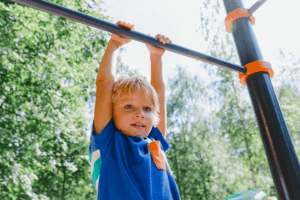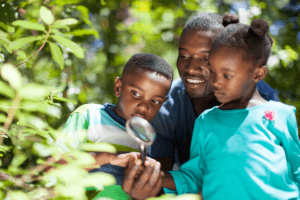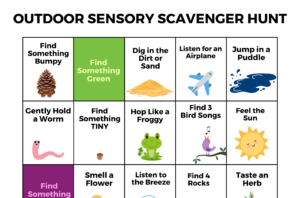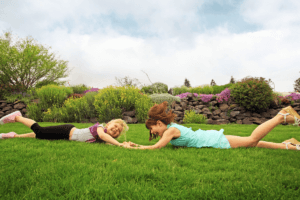Summer is Here What better way to make the most of beautiful weather than with engaging outdoor sensory activities from Judson Center? The flowers are blooming and the weather is warming up, so it’s time to get outside. No matter where you live, the outdoors offers the perfect environment to grow, explore and meet important sensory needs. While many sensory-friendly activities are geared toward children with autism, sensory play is important for children of all ages.
The Importance of Sensory Play
Our senses give us important information thousands of times each day. Children use their senses to learn about and explore the world around them. Providing kids with opportunities for sensory play every single day offers many great benefits. For a child with autism, sensory processing disorder (SPD), or, attention deficit hyperactivity disorder (ADHD), meeting sensory needs supports cognitive development, improves emotional regulation, and increases brain function. Simply put, engaging the senses through play helps children learn and grow. For any child, regardless of an autism diagnosis, sensory activities help them learn essential skills like:
- Grasping Small Items (fine motor skills)
- Balancing and Walking (gross motor skills)
- Developing Knowledge (cognitive skills)
- Reasoning and Planning (problem-solving skills)
- Collaboration (social skills)
- Learning New Words (language skills)
- Expressing Emotions (emotional regulation skills)
The Benefits of Playing Outside
According to the National Association for the Education of Young Children, playing outdoors is a crucial activity for the growth of healthy children. Regular outdoor play can:
- Improve physical health
- Aid in better sleep
- Build an ability to assess risk and make safe choices
- Encourage a love for science and nature
- Develop new social skills
- Lead to better learning outcomes
Make the Most of Playtime
Outdoor sensory activities build a foundation for a healthier, happier child with new skills to help them thrive. Here are some ideas for you, your children, and your whole family to reap all the benefits of sensory play outside this summer!
1. In the Backyard or at Home
- Plant a garden
Plant wildflowers or an edible garden and bring your children along for the journey. Not only is the experience educational, but digging in the dirt, watering flowers, and taste-testing yummy fruits and vegetables make for great sensory activities. - Roll down a hill
Get over those pesky grass stains because rolling down a hill makes for a fun sensory activity. The spinning and rotating results in something called Vestibular Input, a type of movement that causes the fluid of the inner ear to flow and hit important sensory receptors. - Run through a sprinkler
Grab a sprinkler and let the kids run wild! Jumping through and running away from the sprays of water is a great sensory activity that can help cool them down in the hot summer months. - Get creative with water painting
For a more calm water activity, let the creativity flow with water paints. Fill a bucket or bin with water and several paint brushes in various sizes and let your children “paint” the driveway, sidewalk, or porch. Let the sun dry their canvases and they can repeat over and over.
2. At the Playground or Park

- Find a sensory playground
Many playgrounds are built to meet the important sensory needs of children. Look for special playgrounds and structures that make room for swinging, jumping, balancing, music, and nature exploration for a sensory-filled visit! - Hang from the monkey bars
Most playgrounds and parks have monkey bars or something similar for children to play on. The hard grip and swinging required to traverse the bars are important activities that help improve hand strength and coordination. - Play on the swing set
Swinging is an important sensory activity for children with autism or other sensory processing disorders. The use of different kinds of swings in outdoor play not only helps calm children, but helps children engage in movements that will strengthen various skills like coordination, balance, and body awareness. - Walk along the beams
Utilize balance beams or the border around a sandbox or play area to help your child practice balance and coordination. If your child is older you could make the activity more fun by pretending that the ground is lava. Challenge them to get from one point to another without falling.
3. On a Walk or Hike

- Do a sensory scavenger hunt
Explore the outdoors using all 5 senses! Whether you’re out on a neighborhood walk, or hiking in the woods, kids will have a blast searching for items on their scavenger hunt list. You can create your own or use ours HERE to get you started. - Climb a tree
Climbing is an important sensory activity for children of all ages. The pressure they feel in their muscles and joints while climbing helps with internal regulation. Also, the touch of tree bark, branches, and leaves adds an extra layer of tactile sensory fun! - Collect items for a tactile outdoor sensory activities bin
Help your children build an inventory of sensory items to store and explore when they are outside. While on a walk or a hike, gather flowers, sticks, leaves, acorns, rocks, and other items that your kids can use to play with at home. - Do an animal parade
While on a walk or hike, pretend you’re leading your own parade. Have your kids walk and move like the animal you name. The differences between animal actions like breezy monkey swings, big elephant stomps, and playful penguin waddles all result in helpful sensory movements.
3. At the Beach or Lake

- Walk in the Sand
Walk with your child at the beach and sink your toes into the sand. Talk about what it feels like to do this on dry sand and wet sand. - Play buried treasure
Bury sand toys or rocks in the sand and pretend it’s buried treasure. This is a great way to engage your child in sensory play that meets their need for Proprioceptive Input. Proprioception is sensory input children sense in their joints and muscles that tell them where their body is and how it is moving. Beach activities like digging in and carrying sand are great examples of this. - Play beach mummy
Bury your child’s legs and or torso under the sand. The pressure and weight of the sand offer a unique proprioceptive input to help your child learn and develop. For added fun, see if they can be a beach mummy and rise up by pushing through the sand. - Jump over waves
Have fun running toward the waves and jumping over them, or challenge your child to run from the waves and rash back to shore. This is a fun activity to stimulate your child’s senses.
There are endless opportunities for sensory play in the great outdoors! We hope these outdoor sensory activities help jumpstart your summer and make it one to remember as you laugh, learn, and grow together with your child.
Don’t Forget to Download Your Free Outdoor Sensory Scavenger Hunt Sheet!

By Hannah Gregory
Judson Center’s Autism Connections is a preferred provider for diagnostics and early intervention. We have immediate daytime openings available at several locations.
We can help prepare for the school year. Autism Connections offers transportation to and from school, works collaboratively with administrators and teachers to help guide and formulate your child’s IEP.

